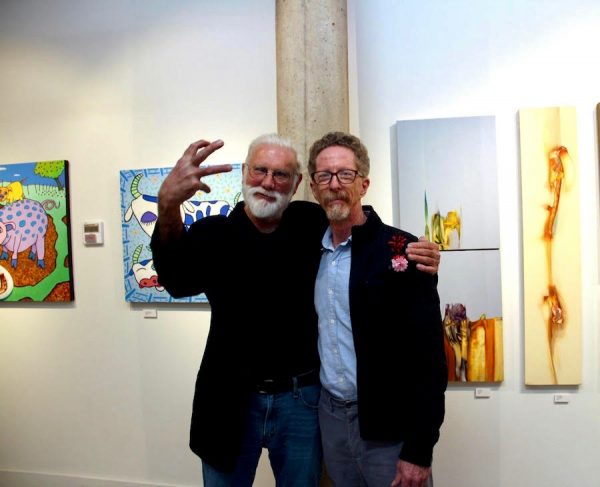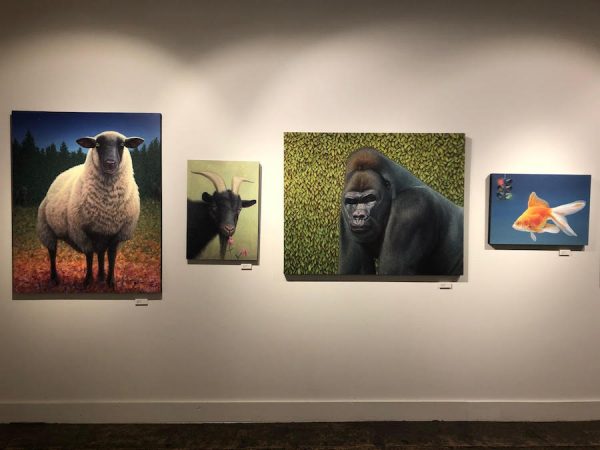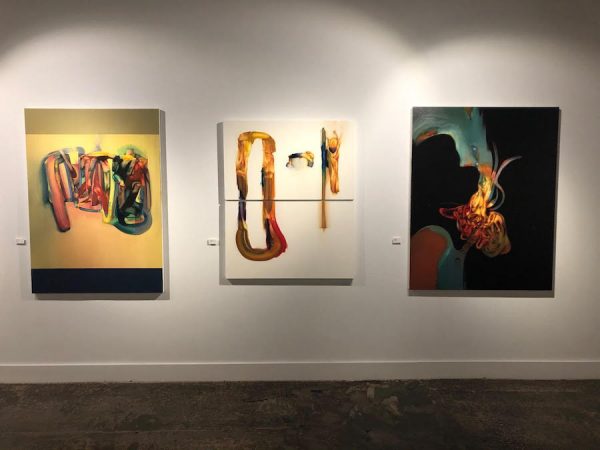Lubbock artist and transplant Jeff Wheeler has put together a boffo show with two of Texas’ finest painters, James Cobb and James W. Johnson. Located in C7, San Antonio’s newest contemporary art space, the exhibit is a showcase for two masters who have spent decades experimenting with styles and substance. (The show has been extended through March 7.)
James Cobb has worked in San Antonio both as an artist and musician. His career gained steam in the 1980s and ‘90s with exhibits at the Contemporary Arts Museum in Houston, The Metropolitan Museum of Art, and the San Antonio Museum of Art.
James W. Johnson moved to Lubbock from upstate New York in 1978, and I can honestly say I’ve never seen an artist with such a breadth of styles and processes. His painting jump from a dizzying range of ideas and images, defying any classification.
It was a pleasure to meet and chat with two unique and insightful art veterans.
Gary Sweeney: Do you remember your first experience with art?
James Cobb: My first experiences with art involved contemplation of album-cover art, including Neil Fujita’s painting used as the cover for Brubeck’s Time Out LP. My first face-to-face experiences were fascination with the large-scale litho Custer’s Last Fight from the Cassilly Adams painting, in the basement of the St.Louis Museum of Art, and upstairs the painting by George Caleb Bingham The Jolly Flat Boatman.
James Johnson: My first experience with real art was when I was 18, on a trip to Europe with a friend, and we went into the Louvre. I was blown away and quickly realized that there was such a thing as an artist, a person who actually spent his or her life making art. A year or so later while in college for chemistry, I took an art appreciation course that offered an optional figure drawing class in the evening. I went to that and discovered that art can be taught. After thinking I had no “talent,” I decided I wanted to learn how to do that. Within my first semester of studio classes, I decided I would spend my life learning and making art.
GS: How would you describe your work to someone who has never seen it?
JC: Abstracted forms from nature; man-made infrastructure.
JJ: I would describe my work as mostly paintings that are interpretations of life as I see it. The visual realization depends on what I’m observing or want to “say.”
GS: Who were your early influences? Did you have a mentor?
JC: Big Daddy Roth, Murph the Surf, psychedelic handbills from the Fillmore and Avalon Ballrooms, underground comix (R. Crumb, S. Clay Wilson), the Hairy Who, Ed Paschke, the German Expressionists, Blaster Al Ackerman. Yes, I had mentors. As I transitioned into considering my longtime image creation in a wider art context, I had mentors in both Blaster Al Ackerman and Rhoda Mappo Hockett.
JJ: I would consider Thom Seawell, my first printmaking and drawing professor at the State University of New York at Oswego, to be my mentor. He was the person who made artmaking sound like the most important thing in the world. His advice was draw something every day, read an art history book a week, make art about your life, and just crank it out. It was advice I took. Because of that, there are numerous artists in the history of art that became inspirations and influences. Too numerous to mention and an ever-changing list as I developed as an artist.
GS: If you could have any piece of artwork, and money wasn’t a factor, what would it be?
JC: Yeah, that one’s basically impossible for me. I don’t have much of a possession impulse. I do own and live with plenty of art that I love, mostly through decades of trades with contemporaries, but I truly can’t imagine a Cy Twombly, an Anselm Kiefer, a Joan Mitchell, a Bacon, Stella, or an Egon Schiele landscape — all work that I greatly admire. Impossible. Maybe a very tiny one?
JJ: I would want Bronzino’s painting Venus, Cupid, Folly and Time. It has almost everything that I like in a work of art: formal and sensual beauty, mystery, humor, and a touch of the bizarre.
GS: If you could change the gallery system from what it is today, what would you do?
JC: No clue, really. I think the gallery paradigm, as formal interface between art and the public, and especially as the entirely problematic intersection of art and commerce, cannot ever function in a way that ultimately makes sense. It’s okay. That art/commerce intersection should always be difficult. Like magnetic repulsion. That there are so many artists and gallerists laboring out of love helps keep the messy confluence navigable.
JJ: To me, the gallery system is a complex combination of art and commerce and there are a variety of ways that people approach that. They can do whatever they want, and I am willing to work with some if I trust them and they don’t try to tell me what to do. My primary concern is just making art and avoiding having a real job, which I have managed for the last 30 years. And it seems to me that every year brings new ways and venues for getting one’s art seen.
GS: Do you struggle with creating your artwork, or does it flow out of you easily?
JC: Sometimes I struggle, especially when I consciously stretch. Sometimes it flows.
JJ: After spending about 80,000 hours making art, I’ve developed a comfortable system of having one piece leading to another, even though the second may or may not resemble the first. I often take a breath after finishing a piece, and contemplate what I want to say now, how do I want say it, and sometimes, it’s just a matter of how do I feel like painting now. After a while, making art is just a way of life, and the process of staying engaged and passionate about what you are doing is of primary importance. In most any piece, there are aspects that can feel like a struggle and other parts that are just plain fun. Usually, I love starting a piece and finishing a piece, with the middle being the most “work.”
GS: Briefly describe how you arrived at your current style.
JC: A slow evolution into finding deeper inspiration from nature, a desire to imbue serenity with energy, complexity with simplicity, and an attraction to ambiguity.
JJ: My current “style” is many styles. I wrote a manifesto in 2002 about what I called Anti-Stylism which purports the idea that the “style” of a work of art should be determined by what the artist wants to “say” and how he or she wants it perceived. I would probably call it Multi-Stylism, now that I am not as reactionary as I once was. (Go here for the manifesto.)
GS: What’s the best piece of advice you can offer students?
JC: The only sustainable pot of gold truly attainable to any artist is to consciously work to keep your practice bringing you joy. All other very worthy goals will have ultimately fleeting rewards. Keep the joy. Get it early and keep it long.
JJ: The best advice I would give to students is what I mentioned above from Thom Seawell: “Draw something every day, read an art history book a week, make art about your life, and just crank it out.” How long and how well one might make art depends on one’s commitment. Only time will tell… .
GS: Talent — do some have it, and some don’t?
JC: Yes, of course, and we all have many number of different talents. Any one talent alone, however, doesn’t add up to much.
JJ: Talent or no? I think some people are born with manual talents, like the ability to draw, build or carve. Some are born with talents of the mind and imagination. Some are born with the total package. But if one doesn’t make a conscious choice to develop and use both, talent doesn’t mean much. I also believe some people aren’t born with much talent but they do have an ability to learn. I’ve always thought of myself as the latter who chose to become the best that I could. The final determination on whether or not I ever had any talent is irrelevant. I will have already spent my life doing something I love.
GS: What’s your chief strength as an artist?
JC: Perseverance.
JJ: My chief strength as an artist is never allowing myself an alternative to making art as a way to spend my life. And maybe my optimism that the next painting may turn out to be my “best.”
GS: Which artist or artists would you travel a great distance to see?
JC: It’d like to see the Hiroshima Murals, by Iri and Toshi Maruki. I did travel to see the Collection de l’art Brut in Lausanne, Switzerland, and I’d like to see Monet’s Water Lilies at at the Musee de l’Orangerie, Paris.
JJ: Hmm. I traveled a fair amount when I was younger and saw many great museum pieces. Now, I’m not very interested in traveling, but I would definitely drive 500 miles to see a major exhibit of someone like Bronzino. In truth, at this point in my life, I get as much pleasure from being surprised by the work of contemporary artists that are relatively unknown as I do from seeing “celebrity” pieces or artists.
‘James W. Johnson & James Cobb: AN OPEN DOOR‘ through March 7 at C7 in San Antonio.







3 comments
Thanks, Y’all.
I’m so glad someone is wondering about the question . “Do some artists have talent”?I wish I could of seen this show The Dirty Projectors have a new single out .. called “Overllord” everyone should check it out..
I’ve asked for correction, but this keeps slipping through the cracks. I’ve never shown at the Metropolitan Museum of Art. I’ve shown at the Osaka Metropolitan Museum of Art as part of a large group show put together by Shozo Shimamoto, one of the cofounders of the Japanese Gutai movement. Pleased to be a part of it and I had a pleasant afternoon visit with Shimamoto In Osaka, but my work (a dozen stencil pieces) vanished in return mail never to be found. I received the work of a Dutch artist…a 60’ long printed roll…which I sent on to the Netherlands. Good times! But not the MET.